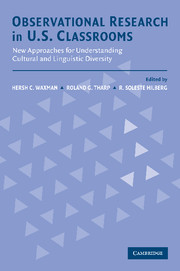 Observational Research in U.S. Classrooms
Observational Research in U.S. Classrooms Published online by Cambridge University Press: 23 November 2009
Through the Comprehensive School Reform Demonstration (CSRD) program (Public Law 105–78; see Doherty, 2000) and Title I School-Wide programs (Natriello & McDill, 1999), there is currently considerable impetus for reforming education using whole-school change models. Implementing comprehensive school reform (CSR) programs requires tremendous commitment and effort by school districts and their individual schools. As the literature on school reform indicates, it also takes time (Bodilly, 1996). What the public, media, and school boards sometimes fail to understand is that programs by themselves are not what improve student learning. Rather, the critical factor is the positive changes that the reforms engender in school climate, resources, and, most critically, the quality of classroom teaching and learning. But whether achievement effects are evidenced in a relatively short period, as occurred after 2 years in Memphis (Ross et al., 2001) or, more typically, after 5 or more years (Herman & Stringfield, 1995; Levin, 1993), key stakeholders (e.g., the public and school boards) want fairly immediate information about what is happening in the schools to justify the reform effort. At the same time, teachers and administrators within schools need formative evaluation data to know whether their efforts are producing the tangible changes desired.
These considerations prompted our development of the School Observation Measure (SOM; Ross, Smith, & Alberg, 1999), the instrument to be described in this chapter.
To save this book to your Kindle, first ensure [email protected] is added to your Approved Personal Document E-mail List under your Personal Document Settings on the Manage Your Content and Devices page of your Amazon account. Then enter the ‘name’ part of your Kindle email address below. Find out more about saving to your Kindle.
Note you can select to save to either the @free.kindle.com or @kindle.com variations. ‘@free.kindle.com’ emails are free but can only be saved to your device when it is connected to wi-fi. ‘@kindle.com’ emails can be delivered even when you are not connected to wi-fi, but note that service fees apply.
Find out more about the Kindle Personal Document Service.
To save content items to your account, please confirm that you agree to abide by our usage policies. If this is the first time you use this feature, you will be asked to authorise Cambridge Core to connect with your account. Find out more about saving content to Dropbox.
To save content items to your account, please confirm that you agree to abide by our usage policies. If this is the first time you use this feature, you will be asked to authorise Cambridge Core to connect with your account. Find out more about saving content to Google Drive.